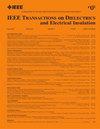Accelerated Laboratory Aging of Synthetic Ester Dielectric Liquid
IF 3.1
3区 工程技术
Q2 ENGINEERING, ELECTRICAL & ELECTRONIC
IEEE Transactions on Dielectrics and Electrical Insulation
Pub Date : 2024-11-18
DOI:10.1109/TDEI.2024.3501995
引用次数: 0
Abstract
Synthetic esters are liquids used in the lubricant industry, but also in the electrical industry for insulation and heat transfer. In this work, the synthetic ester is exposed to high temperatures to initiate and propagate the degradation reactions, study the degradation process, and investigate the effect of paper and water on thermal degradation. After 672 h of thermal exposure, there is no sludge, but the color of the samples is significantly changed. Fourier transform infrared spectroscopy (FTIR) is used to assess the occurrence of degradation products, the neutralization value is used to determine the total acidity, and the relative permittivity is used to correlate the influence of degradation products on the dielectric properties of the synthetic ester. Nuclear magnetic resonance (NMR) and color analysis are used to investigate the appearance and composition of the degradation products of seven selected samples. The NMR study shows that the change observed in the FTIR spectra, the neutralization value, and the relative permittivity as a function of aging conditions correspond very well with the size and shape of the 1 H NMR peak of 3.51 ppm, confirming that the formation of alcohols, ethers, and cross-links is responsible for the aging of the ester. It is found that the color change is misleading when it comes to the degradation of the synthetic ester dielectric liquid.合成酯介电液体的实验室加速老化
合成酯是用于润滑剂工业的液体,也用于电气工业的绝缘和传热。本文将合成的酯暴露在高温下引发和传播降解反应,研究降解过程,并研究纸和水对热降解的影响。热暴露672 h后,无污泥产生,但样品颜色发生明显变化。用傅里叶变换红外光谱(FTIR)评价降解产物的发生,用中和值确定总酸度,用相对介电常数关联降解产物对合成酯介电性能的影响。采用核磁共振(NMR)和颜色分析研究了7个选定样品的降解产物的外观和组成。核磁共振研究表明,FTIR光谱、中和值和相对介电常数随老化条件的变化与1 H核磁共振峰3.51 ppm的大小和形状非常吻合,证实了醇、醚和交联的形成是导致酯老化的原因。研究发现,在合成酯类介电液的降解过程中,颜色变化具有误导性。
本文章由计算机程序翻译,如有差异,请以英文原文为准。
求助全文
约1分钟内获得全文
求助全文
来源期刊
CiteScore
6.00
自引率
22.60%
发文量
309
审稿时长
5.2 months
期刊介绍:
Topics that are concerned with dielectric phenomena and measurements, with development and characterization of gaseous, vacuum, liquid and solid electrical insulating materials and systems; and with utilization of these materials in circuits and systems under condition of use.

 求助内容:
求助内容: 应助结果提醒方式:
应助结果提醒方式:


